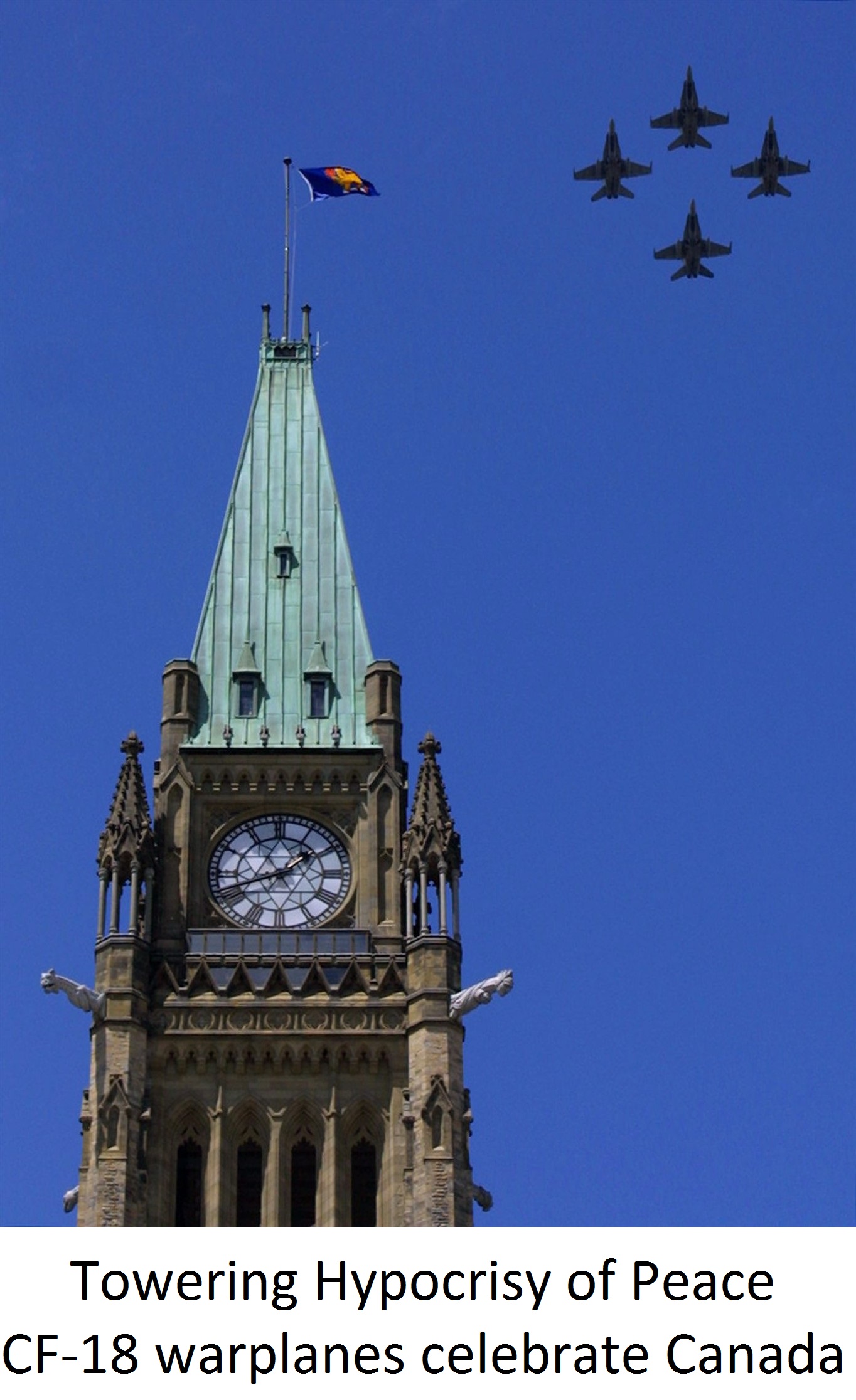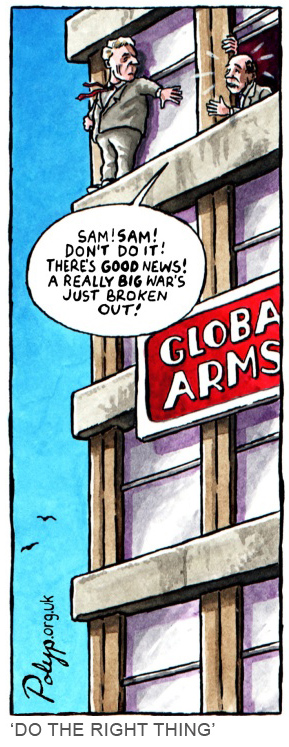|
By Richard Sanders,
coordinator of the Coalition to Oppose the Arms Trade and the editor of its
publication, Press for Conversion!
When wars are launched, or flashy new missiles fired, investor confidence in the arms trade soars skyward like a blazing rocket, and so do the profits of war industries. Most Canadians have no idea that thanks to our Canada Pension Plan (CPP) we are forcibly conscripted into an institutionalised confidence scheme tied to the age-old racket of war. In this scam however, even the con artists and shills who run the con game are often unaware that they are drawing us into a vast criminal enterprise.
As a result, the CPPIB has happily invested our pension monies in a wide range of companies that profit directly and indirectly from war. The most egregious examples of this can be found among CPP investments in the world's largest weapons manufacturers. Our government-sponsored retirement portfolio includes about $1.4 billion worth of stocks in some of the world's largest 100 war industries. The bigger the weapons producer, the more likely we are to be invested in it. For instance, while the CPP has stakes in 41% of the top-100 weapons manufacturers, our shares include 48% of the top 50, 80% of the top 20, and 100% of the top 10. (See the details here.)
And then there are the crimes against truth. Most Canadians have no idea that the CPPIB has invested billions of dollars not only in war profiteers, but in many companies that lead the world in oil extraction, gas pipelines, mining operations, sweat shops, pharmaceutical fraud, and production of the world's deadliest drug -- tobacco. We shouldn't be surprised. Once the Liberals changed the CPP legislation in 1997 so that our pensions were to be played in the stock-market casino, its sole investing mandate has been to achieve a "maximum rate of return, without undue risk of loss." Under these terms, the CPPIB is legally bound to ignore ethical issues. It is raw capitalism. Few Canadians realise that their retirement nest egg is being incubated on a deadly bed of war, environmental destruction, human exploitation and disease. Meanwhile, many Canadians -- even some progressive activists -- continue to willingly invest in the mythology that Canada is a benevolent force that stands for peace in a world plagued by conflict and war. This widespread, self-congratulatory myth is perhaps our peace movement's greatest obstacle. To surpass this stumbling block, activists must undermine widespread public confidence in our nationalistic peace mythology by exposing the glaring contradictions between what Canada actually does to profit from war, and the official narratives which obfuscate that discomfiting reality. Canada's role as America's biggest supplier of military hardware, totalling several billion dollars worth per year, our strong commitment to the NATO pact, and our deep integration in the US war machine, all give truth to the lie that Canada is a global force for peace. The CPP's unethical investments in war industries also provide us with another contradiction that we can use to debunk the farcical, official narrative. By exposing the fact of Canadian complicity in war, we can struggle forward in our efforts to raise public awareness and press for more radical social change.
For example, on April 14, exactly one month before Mother's Day, the US air force smashed the Afghan countryside with what is endearingly called the "Mother of All Bombs," or MOAB. Officially, this stands for "Massive Ordnance Air Blast." Although MOABs have been dropped in military exercises, this was its first use in battle. Weighing in at about 23,000 pounds, this bomb obliterates everything for a km in every direction. MOABs are useless without a delivery system. This one was dropped by a modified "Hercules" transport warplane called an MC-130H, or "Combat Talon II." It is manufactured by Lockheed Martin, the world’s top-ranking war industry, in which the CPP has a $57 million stake.
The dramatic images of missiles launched from a US warship not only created a boom in business for Raytheon, Fortune magazine also reported that this strike "instantly added nearly US$5 billion" to the collective stock value of four other weapons makers. Both Fortune and CNN reported that market prices for Raytheon, Lockheed Martin, Boeing, Northrop Grumman and General Dynamics all skyrocketed thanks to this US attack. Our CPP investments also surged. In their wisdom, the CPPIB had $251 million invested in these five US weapons manufacturers, which have been among the world's top-six war industries for at least two decades.
Another US war stock that Canadians are forced to own through the CPP, is Huntington Ingalls Industries (HII). It built the USS Porter (a.k.a. "Freedom's Champion") and the USS Ross (a.k.a. "Fortune Favors the Brave"). These are the two guided-missile destroyers which launched 59 Raytheon missiles against Syria. HII, a spin off from Northrop Grumman, is now the world's twelfth largest war industry.
Besides building
nuclear-powered aircraft carriers, submarines and destroyers, HII is
involved in producing nuclear weapons. According to the latest annual Dutch
report (Don't Bank on the Bomb, 2016), HHI helps manage
the
HII isn't the only CPP investment in nuclear weapons' companies. The CPPIB invests $425 million in 13 other corporations that are integral to nuclear weapons' programs. (See the details here.) For instance, Lockheed Martin churns out a slew of major weapons delivery systems including the F-16 "Fighting Falcon." On April 17, this warplane test fired an inert nuclear bomb, the B61-12, over Nevada. This new and improved nuclear weapon will replace B61s now deployed in Italy, Belgium, Germany, the Netherlands, and that stalwart supporter of western democracy, Turkey.
By 2021, the US expects to start mass producing about 500 of America's newly-refurbished B61-12 nuclear bombs. Lockheed Martin's F-16s won't be the only warplanes tasked to fire them. They will also be delivered by Northrop Grumman's B-2s and B-21s, Boeing's F-15Es and European-made bombers called the "Tornado." Their maker, Panavia, is 42.5% owned by BAE Systems, Britain's leading war profiteer. The CPP includes about $318 million in these four war contractors.
That same day, Israel received three more F-35s for its air force. Then, on May 2 (Israel Independence Day) their F-35s screeched across the sky over Israel and the occupied Palestinian territories. These overflights publicly brandished Israel's new wartoys to inspire celebrations of the state's creation. But the F-35 isn't just for show. One of these warplanes, that it received last December, has reportedly used in a missile strike against Syria in January. While Lockheed Martin is the F-35s prime contractor, many other war industries have played crucial roles in its production, and the CPP has invested in many of them as well. As a result, Canadians own $438-million worth of shares in 14 war contractors that build major systems for the F-35. (See the details here.)
The CPP also has $33 million in the UK's BAE Systems, the world's third-largest weapons builder. It produces warplanes, drones, nuclear submarines, as well as army vehicles for the US, Israel and other countries. And, while Turkey has been carrying out a state-terror campaign against its own citizens, Britain's PM and foreign secretary recently met with Turkish president Erdogan to finalise BAE's deal to build new combat warplanes for that country.
The world's sixth biggest war profiteer, Northrop Grumman, recently received media praise for having reached a milestone with its EQ-4B “Global Hawk” targeting drones. These unmanned surveillance warplanes, which thanks to a previous Liberal government did their first test flights over BC and Alberta in 2000, hit the news this March for having completed 10,000 combat missions in Southwest Asia. The CPPIB has $10 million invested in this weapons manufacturer. Another Northrop Grumman spy drone, the RQ-4, can survey 100,000 sq.km. per day. Costing about a quarter of a billion dollars each, some of these drones have just been outfitted with improved weapons-targeting sensors by United Technologies Corp. (UTC). The CPP owns $33 million worth of shares in UTC, which is the world’s 13th largest war industry.
Thales Group, in which the CPP has invested $24 million, is France's largest weapons company, and number 10 globally. Besides making warplanes, missiles and drones, it is the prime contractor that designed Britain's two new aircraft carriers, the HMS Queen Elizabeth and the HMS Prince of Wales. These warships, designed to carry 40 warplanes, including Britain's F-35s, will be tested at sea this summer.
Although we talk a great line, Canadian history is based on a legacy of racism, classism, xenophobia and imperial hubris. For generations, Canadians have wilfully turned a blind eye to the land plunder and genocide that built this country. Similarly, while the CPP forces us to invest in many of the world's most embarrassingly-destructive and deadly corporations, many Canadians still hold stock in the confident delusion that our country is a beacon of peace, democracy and all things motherhoody. This bold cultural narcissism amounts to a social psychosis of national proportions. It is the ultimate fool's game, a highly-systematised confidence scheme. We invest in this naive national mythology of Canadian exceptionalism at our peril, and everyone else's. One way to undermine the faith that so many Canadians still have in the self-righteous narratives that shackle this country, is to expose the truth about the CPP. Operating under the banal protection of capitalism, it ties our security to profiteering from war, exploitation and environmental destruction.
Here are some COAT tables
detailing a variety of current CPP investments: |
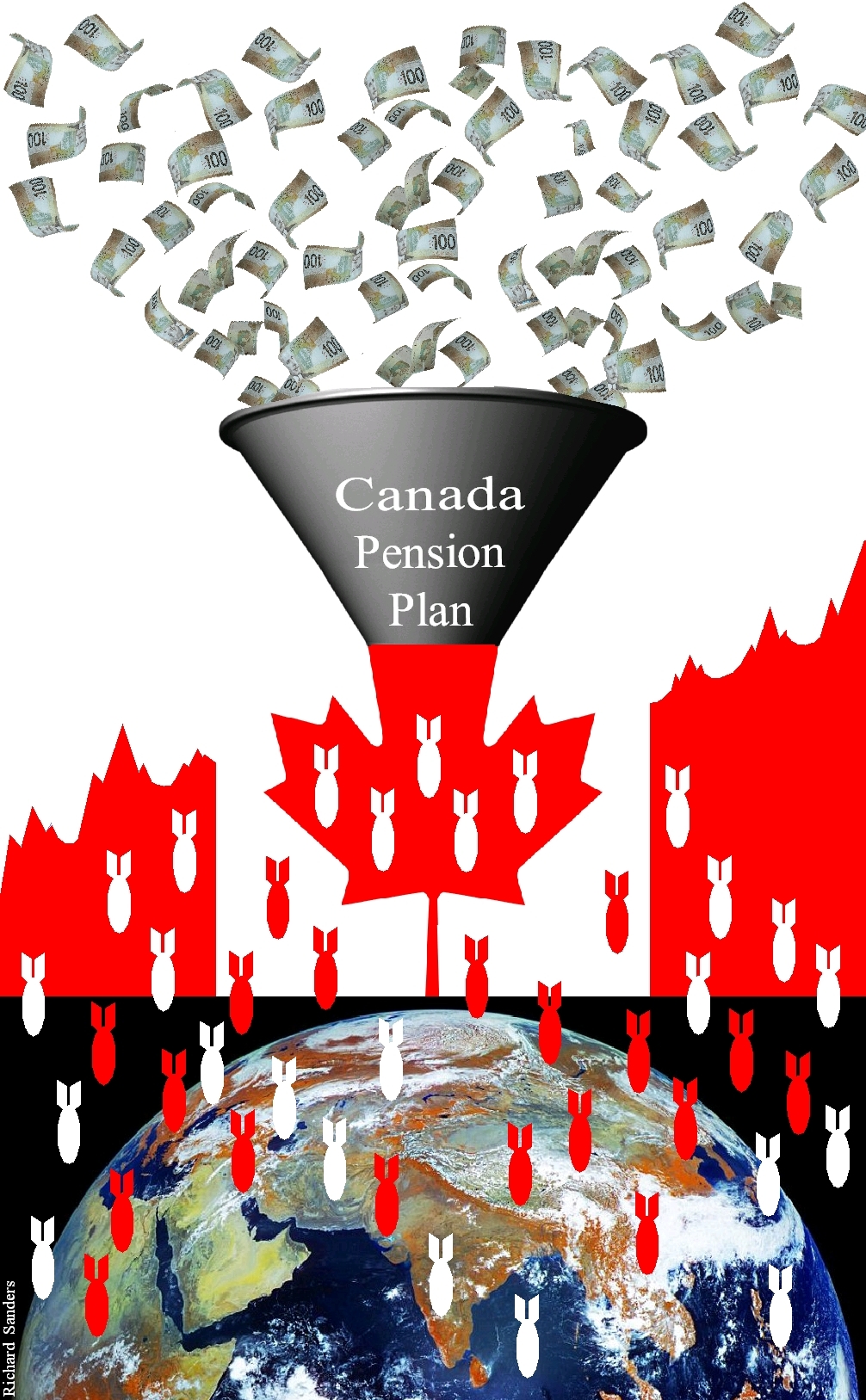
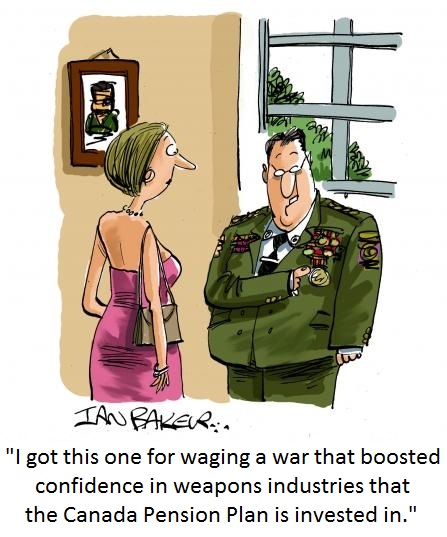 CPP
complicity in this whole bloody war racket makes us captive players in a
market that aids and abets not only the commission of crimes against peace,
and crimes against humanity, but crimes against nature as well.
CPP
complicity in this whole bloody war racket makes us captive players in a
market that aids and abets not only the commission of crimes against peace,
and crimes against humanity, but crimes against nature as well. 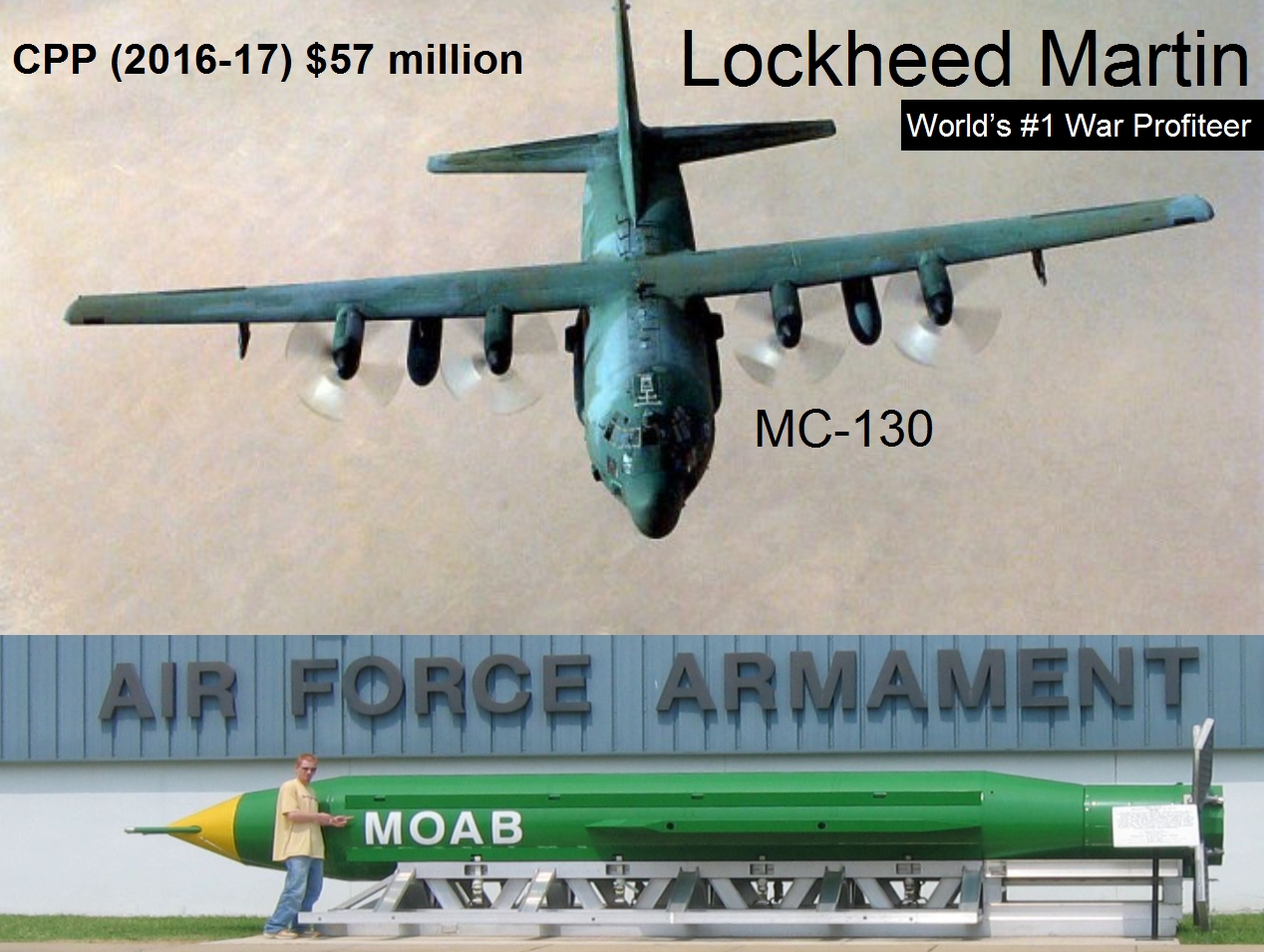 As
an anti-war researcher and activist who has been exposing the CPP's war
investments since 2003, I'm never surprised by the utter depravity of the
corporations we are forced to profit from. This includes over $360
million that the CPP now has invested in world's top ten warmongers. Although these companies
represent only the tip of CPP military investments, it's worth looking at a
few of their shiny but gruesome products that have hit the news recently.
As
an anti-war researcher and activist who has been exposing the CPP's war
investments since 2003, I'm never surprised by the utter depravity of the
corporations we are forced to profit from. This includes over $360
million that the CPP now has invested in world's top ten warmongers. Although these companies
represent only the tip of CPP military investments, it's worth looking at a
few of their shiny but gruesome products that have hit the news recently.
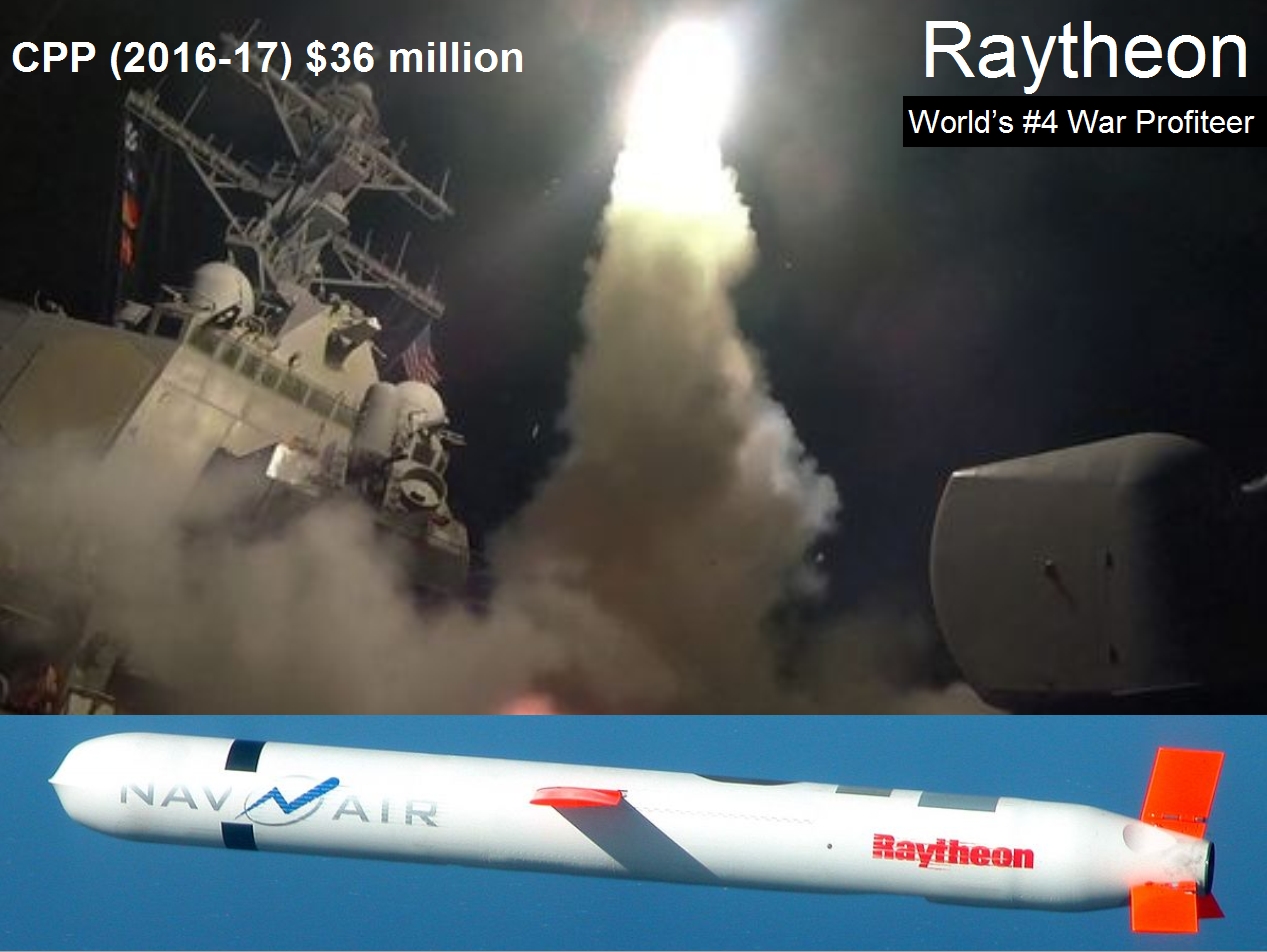 A
week earlier, Fortune magazine informed its readers that America's
cruise missile strikes against Syria had -- in one trading day -- boosted
Raytheon's market value by $1 billion. The sudden appearance of Raytheon's
"Tomahawk" missiles blasting across TV screens around the world was a
weapons advertisers' dream come true. It also signalled a symbolic new level
of commitment to this war against Syria that the our allies have been
fighting indirectly through support for ISIS and other terrorists. The
attack was, in effect, a "product placement" campaign which showed off the
Raytheon brand's prowess in scores of reality TV programs called "the News."
Canadian newscasters did not inform audiences that the CPP's $36 million
investment in Raytheon would be bumped up by their coverage.
A
week earlier, Fortune magazine informed its readers that America's
cruise missile strikes against Syria had -- in one trading day -- boosted
Raytheon's market value by $1 billion. The sudden appearance of Raytheon's
"Tomahawk" missiles blasting across TV screens around the world was a
weapons advertisers' dream come true. It also signalled a symbolic new level
of commitment to this war against Syria that the our allies have been
fighting indirectly through support for ISIS and other terrorists. The
attack was, in effect, a "product placement" campaign which showed off the
Raytheon brand's prowess in scores of reality TV programs called "the News."
Canadian newscasters did not inform audiences that the CPP's $36 million
investment in Raytheon would be bumped up by their coverage.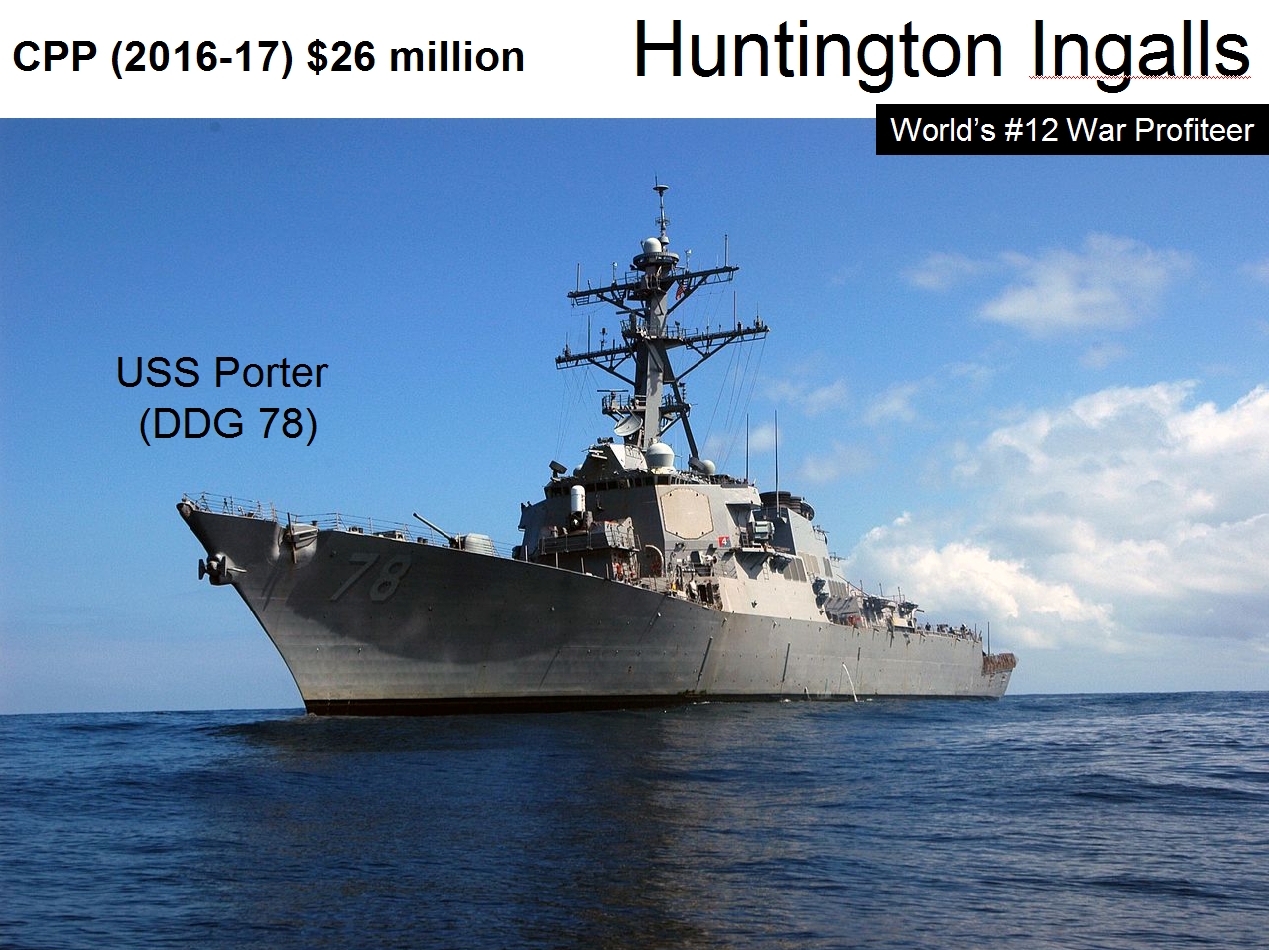 When
other global news corporations joined the media frenzy with their own
promotional ads regaling these weapons makers, the stock values of these war
industry were no doubt boosted even further aloft.
When
other global news corporations joined the media frenzy with their own
promotional ads regaling these weapons makers, the stock values of these war
industry were no doubt boosted even further aloft.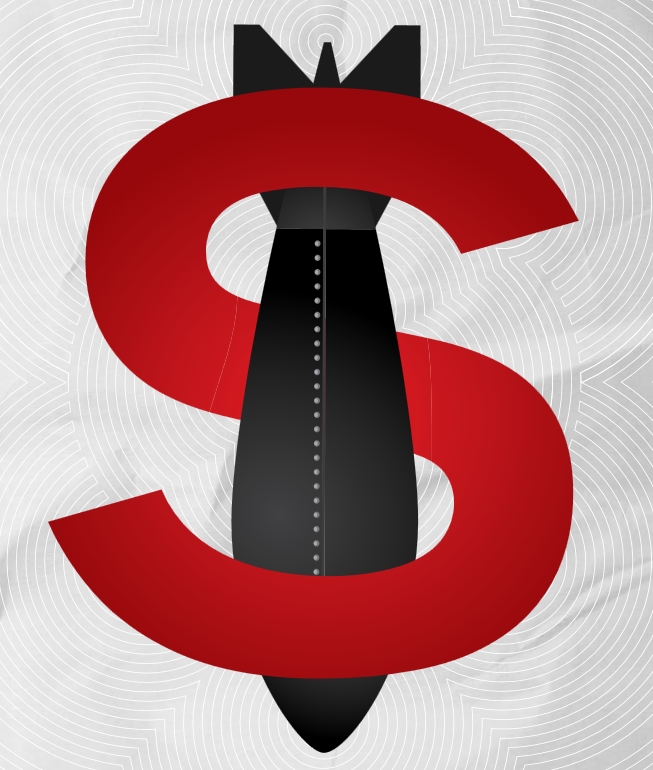 US
nuclear weapons program and is "the only source of new tritium for the US
nuclear arsenal." The company's Tritium Extraction Facility in Georgia
provides radioactive hydrogen essential to US nuclear bombs. Despite this
complicity in nuclear weapons, or perhaps because of it, the CPP's arsenal
of stocks includes $26 million worth of HII.
US
nuclear weapons program and is "the only source of new tritium for the US
nuclear arsenal." The company's Tritium Extraction Facility in Georgia
provides radioactive hydrogen essential to US nuclear bombs. Despite this
complicity in nuclear weapons, or perhaps because of it, the CPP's arsenal
of stocks includes $26 million worth of HII.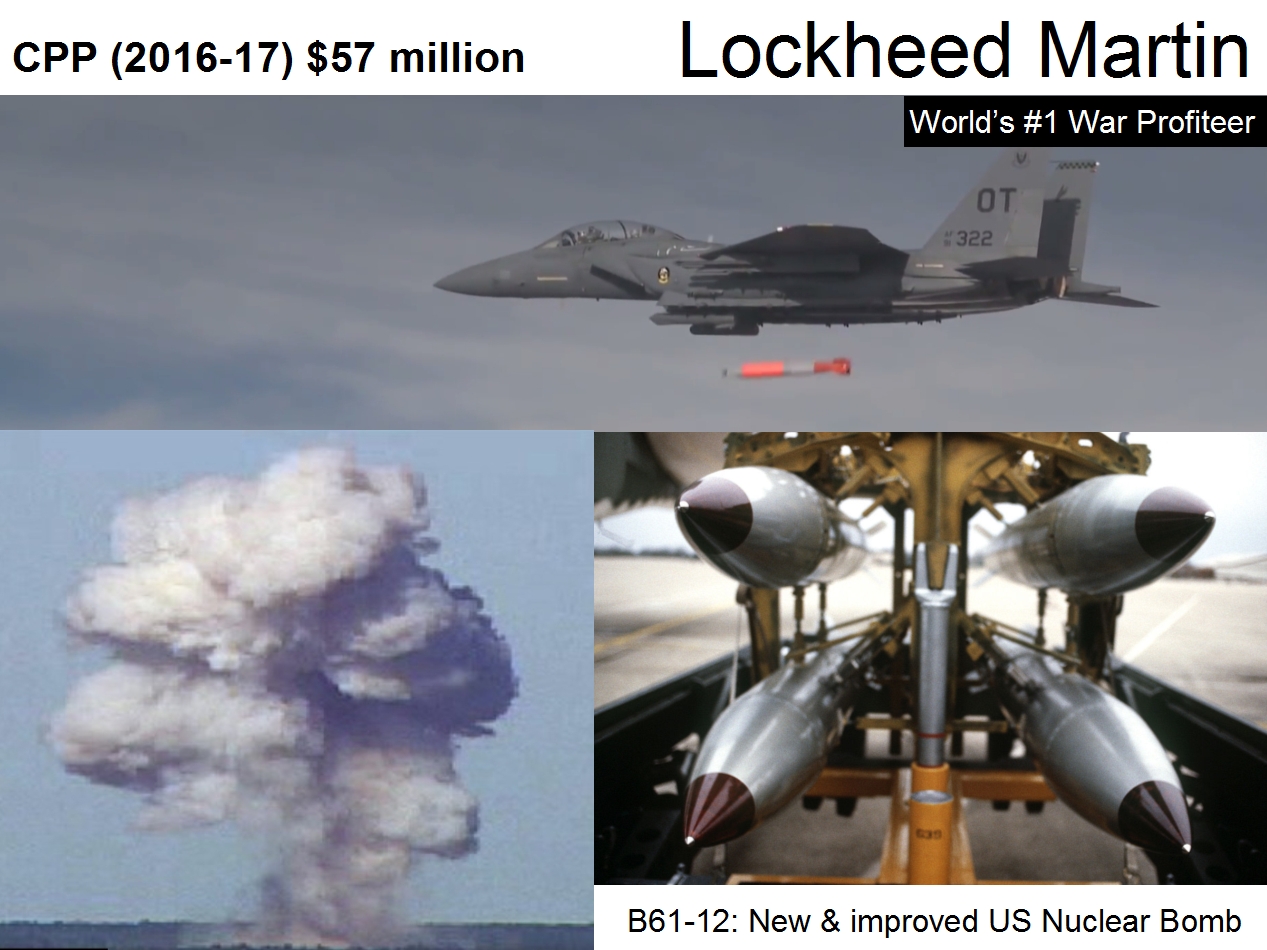 Thanks
to a US$11-billion "life-extension program" for B61 bombs that started under
President Obama's leadership, we can all feel a bit more secure knowing that
F-16s can safely launch these fancy new nuclear weapons. These
"variable-yield" bombs can deliver anywhere from a 0.3 kiloton nuclear blast
to a 340 kiloton explosion. ("Little Boy," the bomb that obliterated
Hiroshima was only about 15 kilotons, while Nagasaki's "Fat Man" bomb was 20
kilotons. Together they killed between 150,000 and 250,000 people.)
Thanks
to a US$11-billion "life-extension program" for B61 bombs that started under
President Obama's leadership, we can all feel a bit more secure knowing that
F-16s can safely launch these fancy new nuclear weapons. These
"variable-yield" bombs can deliver anywhere from a 0.3 kiloton nuclear blast
to a 340 kiloton explosion. ("Little Boy," the bomb that obliterated
Hiroshima was only about 15 kilotons, while Nagasaki's "Fat Man" bomb was 20
kilotons. Together they killed between 150,000 and 250,000 people.)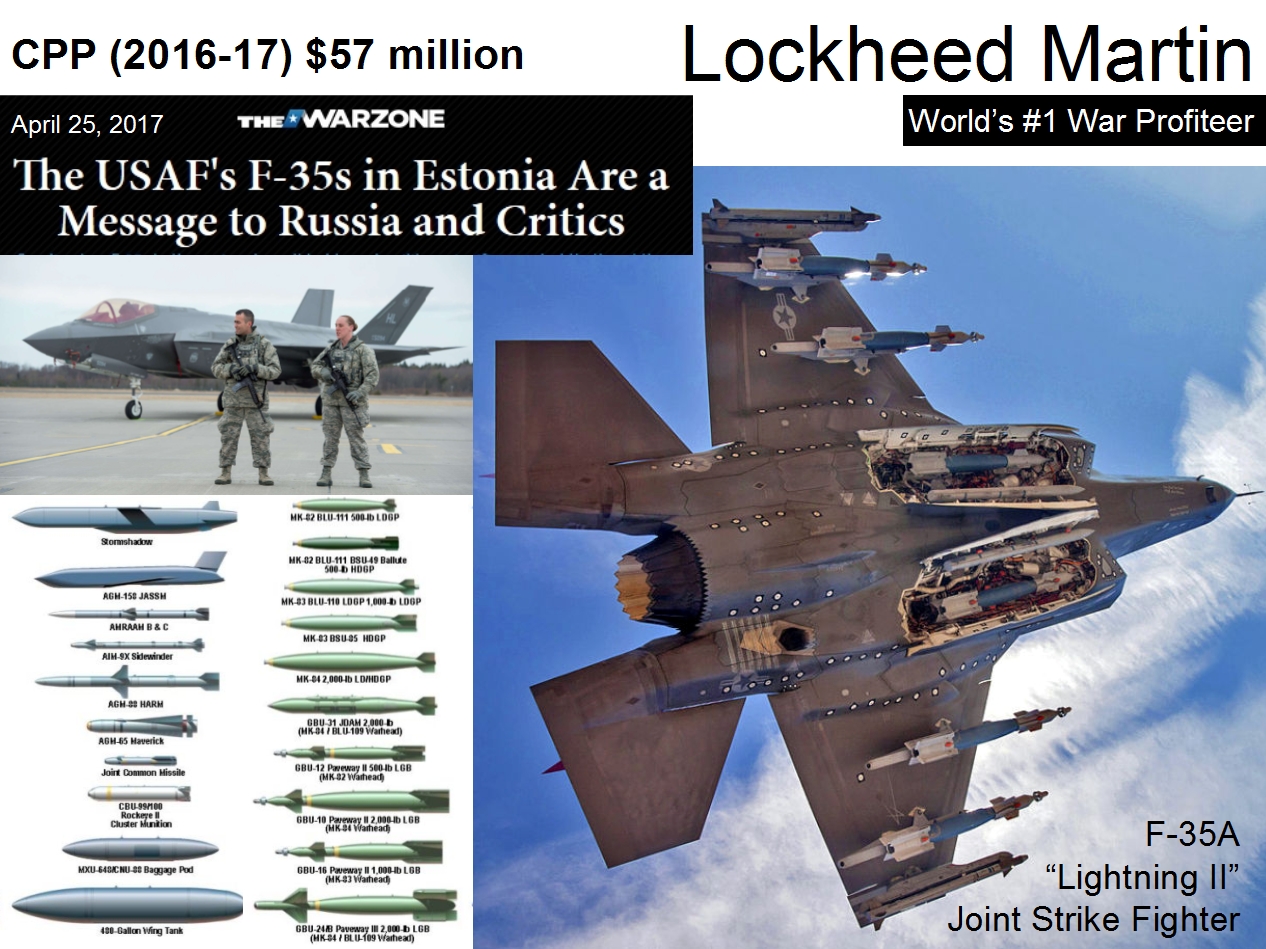 Yet
another warplane designed to launch America's B61-12 nuclear bombs is
Lockheed Martin's F-35 "Lightning II." This warplane is the most expensive
weapons system ever developed. US F-35s made the news in April when they
went on their first overseas operation. This mission, part of a US exercise
called the "European Reassurance Initiative," began under Obama as a
$1-billion-a-year project. Its goal, to bolster NATO confidence and threaten
Russia, blossomed into a $3.4-billion-a-year exercise during his final year
in office. Under this "initiative" Obama sent 5,000 US military personnel,
more than 2,600 vehicles and 84 aviation assets to Russia's doorstep. The
symbolic spearhead of this NATO program is the F-35, and two of these
warplanes arrived in Estonia on April 25.
Yet
another warplane designed to launch America's B61-12 nuclear bombs is
Lockheed Martin's F-35 "Lightning II." This warplane is the most expensive
weapons system ever developed. US F-35s made the news in April when they
went on their first overseas operation. This mission, part of a US exercise
called the "European Reassurance Initiative," began under Obama as a
$1-billion-a-year project. Its goal, to bolster NATO confidence and threaten
Russia, blossomed into a $3.4-billion-a-year exercise during his final year
in office. Under this "initiative" Obama sent 5,000 US military personnel,
more than 2,600 vehicles and 84 aviation assets to Russia's doorstep. The
symbolic spearhead of this NATO program is the F-35, and two of these
warplanes arrived in Estonia on April 25.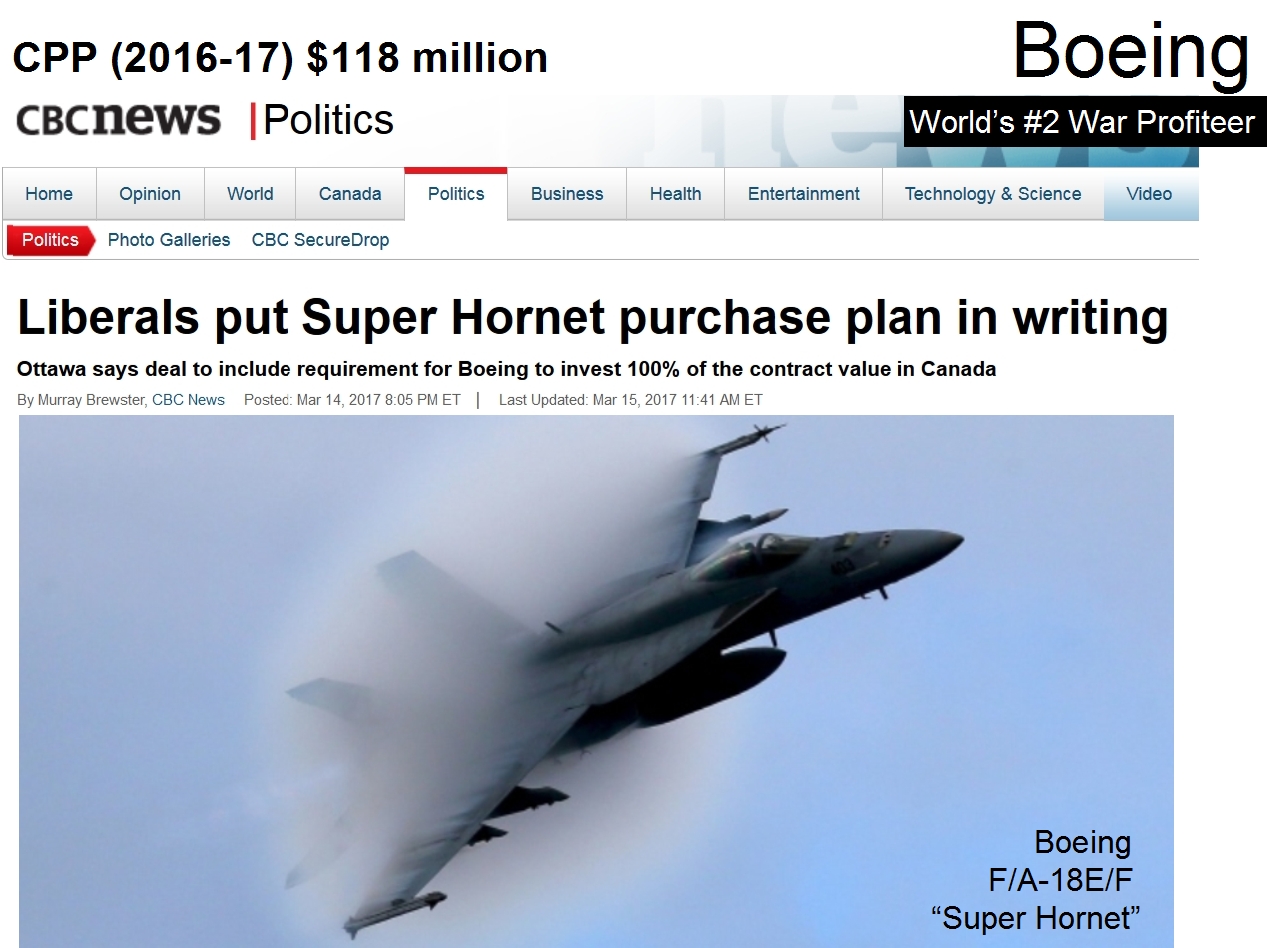 Although
Canada was originally on track to buy 65 F-35s, the Liberal government
cancelled that deal and switched allegiance to Boeing's F/A-18E/F "Super
Hornet." As might be expected, the CPP also holds Boeing stocks,
to the tune of $118 million. On May 12, a Senate committee urged the government to
return to the F-35s, even though just two months ago the Liberals committed
to purchase Boeing's warplanes. Boeing, the world's second largest war
industry, which makes about 30 kinds of military aircraft, also produces
various missiles, laser weapons and the world's largest non-nuclear bomb,
the 14,000-kg "Massive Ordnance Penetrator."
Although
Canada was originally on track to buy 65 F-35s, the Liberal government
cancelled that deal and switched allegiance to Boeing's F/A-18E/F "Super
Hornet." As might be expected, the CPP also holds Boeing stocks,
to the tune of $118 million. On May 12, a Senate committee urged the government to
return to the F-35s, even though just two months ago the Liberals committed
to purchase Boeing's warplanes. Boeing, the world's second largest war
industry, which makes about 30 kinds of military aircraft, also produces
various missiles, laser weapons and the world's largest non-nuclear bomb,
the 14,000-kg "Massive Ordnance Penetrator."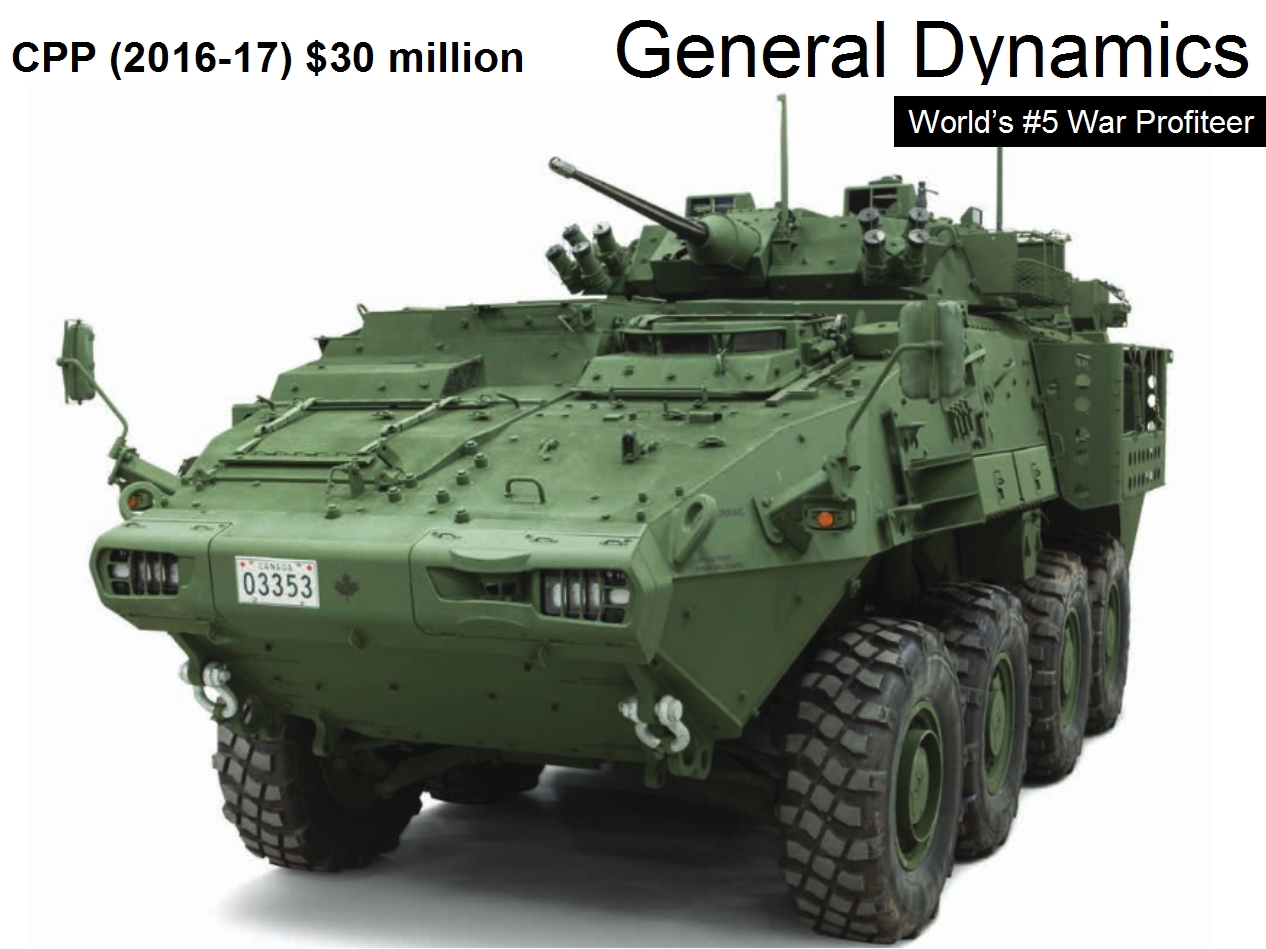 The CPP
holds $30 million worth of shares in General Dynamics (GD), the world's
fifth largest war industry. Besides making warships, battle tanks, and
surveillance technology for the US/Mexico border, GD is now infamous in
Canada for its London Ontario subsidiary. It has
produced thousands of "Light Armoured Vehicles" (LAVs) long used by the US
and other countries for wars in Iraq and Afghanistan. Although it has been
exporting these battle vehicles to Saudi Arabia since 1993, its latest
$15-billion export contract for about 1000 LAVs has finally garnered some
media attention.
The CPP
holds $30 million worth of shares in General Dynamics (GD), the world's
fifth largest war industry. Besides making warships, battle tanks, and
surveillance technology for the US/Mexico border, GD is now infamous in
Canada for its London Ontario subsidiary. It has
produced thousands of "Light Armoured Vehicles" (LAVs) long used by the US
and other countries for wars in Iraq and Afghanistan. Although it has been
exporting these battle vehicles to Saudi Arabia since 1993, its latest
$15-billion export contract for about 1000 LAVs has finally garnered some
media attention.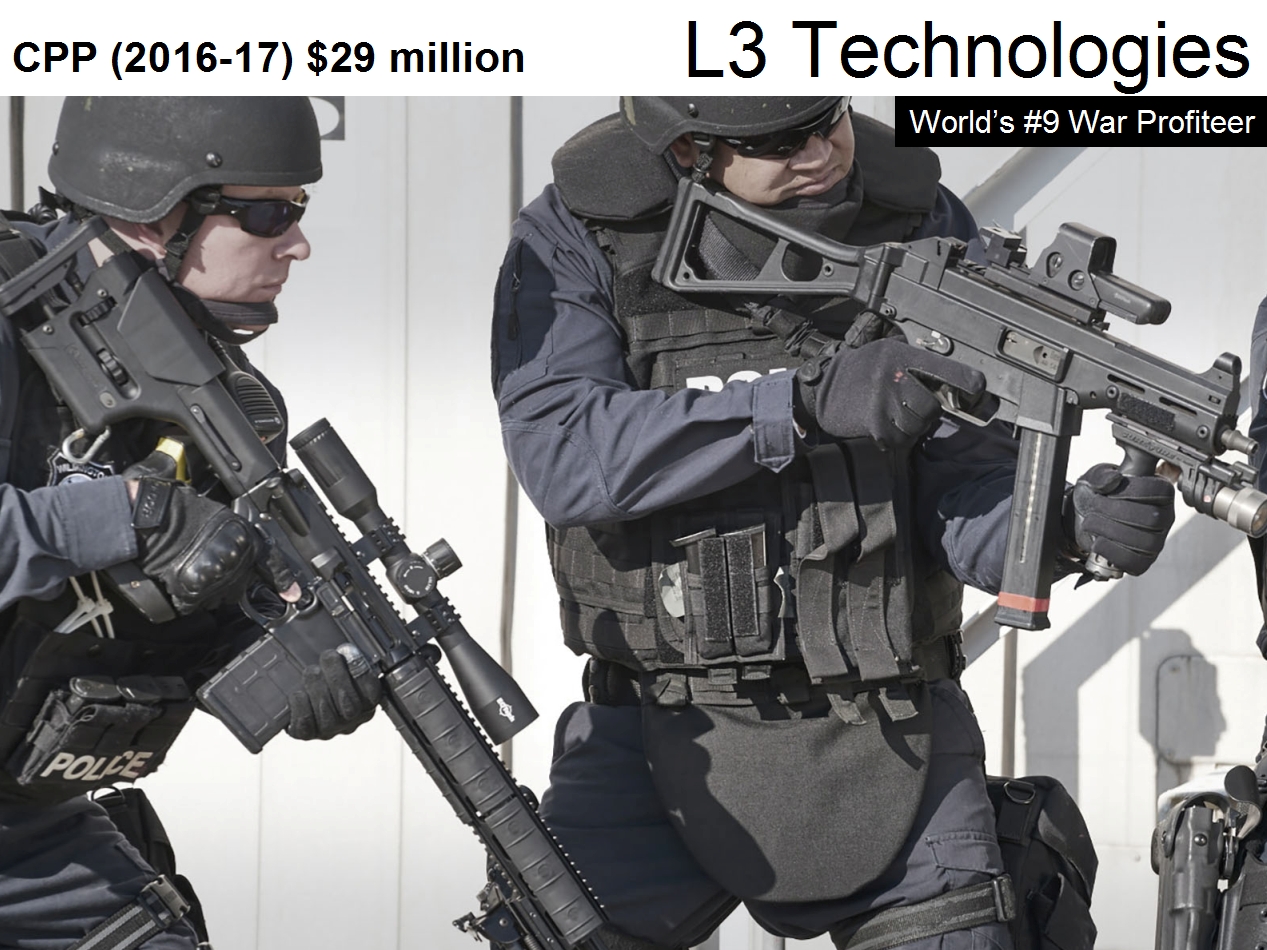 L3
Technologies is a diversified war profiteer that churns out numerous air-,
land- and sea-based military systems. It also makes Holographic Weapon
Sights for US army and police forces. Because these sights don't work
properly, L-3 paid $26 million to the US government after losing a fraud
case. And, this April, L-3 lost a class action suit to civilians who
purchased L3s faulty sights. The CPP has $29 million invested in this
company which is the world’s 9th largest war profiteer.
L3
Technologies is a diversified war profiteer that churns out numerous air-,
land- and sea-based military systems. It also makes Holographic Weapon
Sights for US army and police forces. Because these sights don't work
properly, L-3 paid $26 million to the US government after losing a fraud
case. And, this April, L-3 lost a class action suit to civilians who
purchased L3s faulty sights. The CPP has $29 million invested in this
company which is the world’s 9th largest war profiteer. 